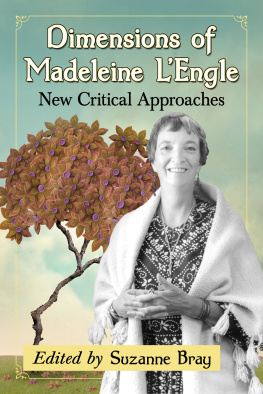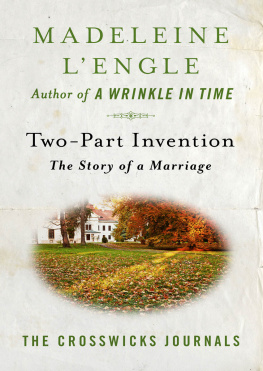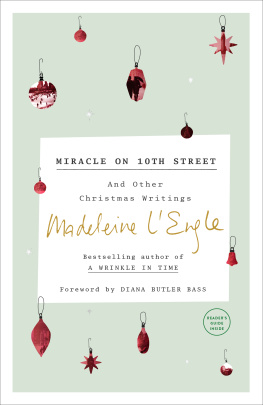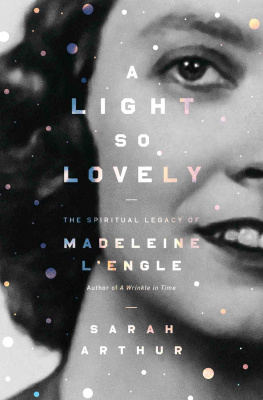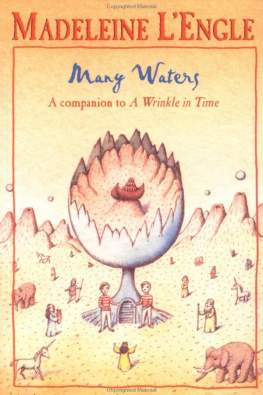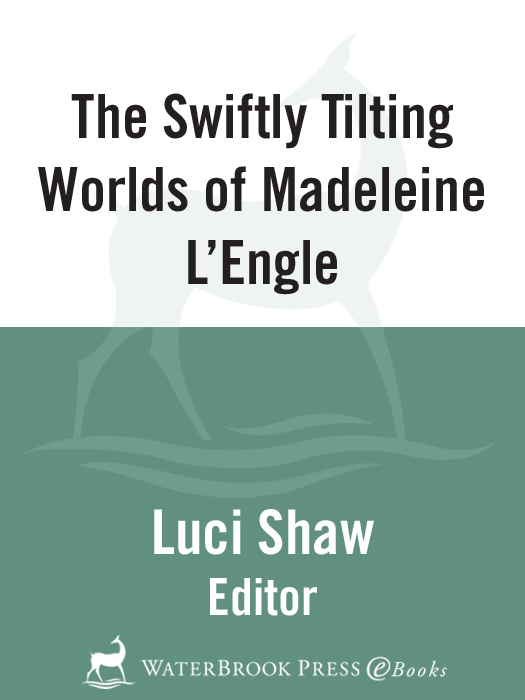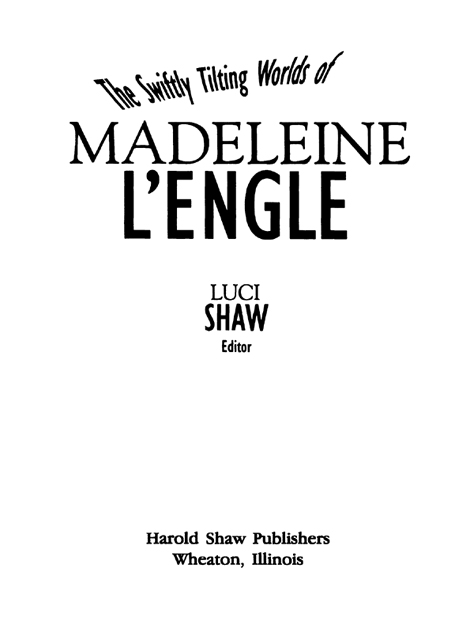THE SWIFTLY TILTING WORLDS OF MADELEINE LENGLE
Essays in Her Honor by
E. Beatrice Batson
Barbara Braver
Thomas Cahill
Alzina Stone Dale
Myrna R. Grant
Emilie Griffin
Donald R. Hettinga
Thomas Howard
Calvin Miller
Virginia Stem Owens
Katherine Paterson
Eugene H. Peterson
Robert Siegel
Luci Shaw
Walter Wangerin, Jr.
Walter Wink
Copyright 1998 by Harold Shaw Publishers
All rights reserved. No part of this book may be reproduced or transmitted in any form or by any means, electronic or mechanical, including photocopying, recording, or any information storage and retrieval system, without written permission from Harold Shaw Publishers, Box 567, Wheaton, Illinois 60189. Printed in the United States of America.
Letters for reprint permission for Saint Patricks Message for Us by Thomas Cahill and Taking the Bible Seriously by Katherine Paterson must be directed to those authors.
All Scripture quotations, unless otherwise indicated, are taken either from the Revised Standard Version of the Bible (copyright 1946, 1952, 1971) or the New Revised Standard Version of the Bible (copyright 1989) by the Division of Christian Education of the National Council of the Churches of Christ in the USA, and used by permission. All rights reserved.
Edited by Luci Shaw
Library of Congress Cataloging-in-Publication Data
The swiftly tilting worlds of Madeleine LEngle : essays in her honor / edited by Luci Shaw.
p. cm.
eISBN: 978-0-307-78180-2
1. LEngle, MadeleineCriticism and interpretation. 2. Christianity and literatureUnited StatesHistory20th century. 3. Women and literatureUnited StatesHistory20th century. 4. Christian literature, AmericanHistory and criticism. I. LEngle, Madeleine. II. Shaw, Luci.
PS3523.E55Z88 1998
813.54dc21
97-49159
v3.1
Contents
1 The Partnership of Art & Spirituality
Luci Shaw
2 Evil in The Wind in the Door
Walter Wink
3 Saint Patricks Message for Us
Thomas Cahill
4 Looking for Truth in the Age of Information
Virginia Stem Owens
5 Gospel Quartet: Jesus in Four Voices
Eugene H. Peterson
6 Taking the Bible Seriously
Katherine Paterson
7 Of Imagination, Story, and Reality
Thomas Howard
8 The Incarnation and Poets-Priests: Herbert and Hopkins
E. Beatrice Batson
9 A World of Light: The Retreate, by Henry Vaughan
Robert Siegel
10 The Joyous Turn: Glimpsing Truth in Stories
Emilie Griffin
11 A Great Cloud of Witnesses
Donald R. Hettinga
12 The Lives of the Saints: Twentieth-Century Style
Alzina Stone Dale
13 In Favor of God
Calvin Miller
14 The Celtic Vision
Myrna R. Grant
15 Madeleine, My Eli
Walter Wangerin, Jr.
16 The Journey of Becoming
Barbara Braver
Madeleine and I have been friends for close to thirty years. It all started at a Wheaton College Conference on Language and Literature where we exchanged books and began to correspond. Later, I became Madeleines editor at Harold Shaw Publishers, the company my husband and I initiated, and to date I have worked with Madeleine on eleven books, during which process it became clear that our spirits were knit. We live on opposite coasts of the continent, but our communication is free and frequent. We often travel and vacation together. She has enlarged my world in more ways than I can ever describe.
Madeleine and I both lost our husbands, Hugh and Harold, to cancer in the same year. Over the years and distance our loving friendship has become intentional enough for us to write a book about itFriends for the Journey (Servant, 1997). We also co-authored WinterSongSeasonal Readings (Shaw, 1996).
When the editorial team at Shaw approached me with the idea of putting together a festschrift in honor of Madeleines eightieth birthday, I thought, Now thats a birthday gift I think Madeleine would like! And here it is!
Luci Shaw
The Partnership of Art & Spirituality
Luci Shaw
In the 1870s Jules Verne, possibly the first sci-fi writer of our contemporary age, wrote his novel The Desert of Ice. In the 1970s The Scientific American took note of a device employed by Verne to extract his protagonists, a band of Arctic explorers, from a seemingly inextricable dilemma. Their wooden sailing ship had been crushed to splinters in the grip of polar ice, leaving them stranded in the uninhabited and inhospitable reaches of the polar ice cap. To rescue them, and to give his novel a more felicitous ending, Verne tells how these inventive adventurers carved an ice lens from clear ice, through which they focused the suns rays on pieces of their ships splintered wood, kindling a life-saving fire that allowed them heat enough to survive until they were rescued. Implausible? The Scientific American thought so until its editors successfully managed to duplicate the experiment and kindle a flame using a lens of ice.
When I read the account of this kindling of fire from ice, somehow my imagination was also kindled; the story cried out to me to be written into a poem. Consider the resulting work, Saved by Optics.
Saved by Optics
First, they must find a chip of cold
that has always wanted to see,
to channel the light.
Then, with hands devoid
of electricity
without matches, even,
and with only splinters
of strength left
they must carve it outthe rough
eyeballfrom under the brow of this ice continent
and polish it between
their curved palms last warmth
into the double convex of a lens
a gem without frost, or crack,
cleansed by the flow of its own tears.
Next, they must wait, shivering,
for the slow sun
to reach the zenith of his readiness
to work with them. Now.
Focused in the eye of ice
(angled exactly,
though its chill slows each of their fingers bones)
a matchless flame collects
until the concentrated scrutiny of light
reads the dry tinder into
a saving kindlingices gift of beat, and paradox.
I had felt no compelling theological motivation to write this poem, simply a fascination with an intriguing physical phenomenon. But much later, as I reread the completed poem with a more critical eye (the fires of composition having cooled), I became aware of some correspondences I had not noticed before.
Here was a group of helpless, hopeless human beings in a crisis of existential need, on the verge of extinction in the Arctic freeze, condemned to die by their own inability to create enough warmth to survive. Cold is the antithesis of energy and life, and they were utterly vulnerable to it, their own small internal wick of flame too easily snuffed, their one source of heat being the remote sun, its energy untapped until a creative mind applied a simple principle of physics to the situation. The link between the helpless humans (without strength is the biblical phrase that comes to mind) and God, the source of all light, warmth, life, was a lens, Christ become human,


